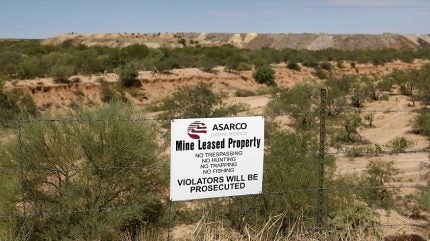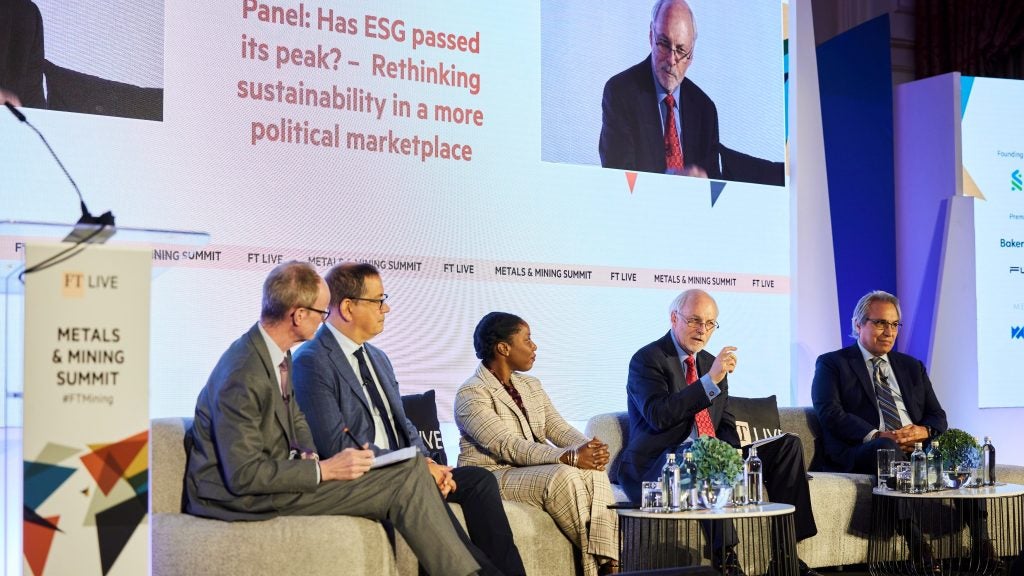
ESG – environmental, social and governance – strategies were the hot topic of the early 2020s, but policy researchers generally agree that the hype has faded, leaving the substance open to scrutiny.
Analysis by Mining Technology’s parent company, GlobalData, reveals the cooling hype but also depicts a disparity between the three parts of the ESG strategy. At ESG’s peak, in 2021, the term ‘environment’ was mentioned in mining companies’ filings 154,301 times, while ‘governance’ appeared 121,834 times. ‘Social’, however, appeared fewer than half that number of times, at 59,449.

Discover B2B Marketing That Performs
Combine business intelligence and editorial excellence to reach engaged professionals across 36 leading media platforms.
This pattern has pervaded across the downward trend. In 2024, ‘environment’ was mentioned 96,928 times, ‘governance’ 76,208 times and ‘social’ 29,313 times.
The emissions-heavy mining sector seemed to be particularly ripe for ESG-framed change, yet a relative neglect of social issues was highlighted at the FT Live Metals and Mining Summit earlier this month.
“We are seeing that ESG is often equated to climate change, whereas ESG is supposed to be a broader scope of sustainability, which we can often lose,” said Stacy Hope, partner at Environmental Resources Management, during an ESG panel at the summit.
Environmental versus social: related but distinct
The common but erroneous synonymising of ESG and environmental consideration became the panel’s primary theme, as speakers highlighted that ESG strategies should better consider the social impacts of mining for communities located near deposits.

US Tariffs are shifting - will you react or anticipate?
Don’t let policy changes catch you off guard. Stay proactive with real-time data and expert analysis.
By GlobalDataThe UN identifies 11 areas of social risk to local communities, at the top of which is land acquisition and displacement. Other risks include socio-economic risks, gendered impacts, the lack of proper implementation of free, prior and informed consent (FPIC) for indigenous communities and the right to a healthy environment.
Former UN special rapporteur and professor of law at the University of Colorado, S. James Anaya, commented on the panel: “Typically, human rights have been thought of as just your basic individual rights, but increasingly, I think it is encompassing concerns about the environment and indigenous peoples.
“Even looking at these issues more broadly than simply through the terminology of human rights, my concern right now really is with this gap between these standards – whether you call them ESG standards, responsible mining standards, human rights – and the actual practices.”
Both in terms of environmental and social ESG considerations, indigenous people have been historically overlooked by the mining sector, which the UN notes has failed to properly implement FPIC. Exploration and mining activities have displaced communities from land of spiritual significance, disrupted traditional livelihoods and destroyed sites of cultural heritage.
A scientific review of scholarship published between 2012 and 2022 on Australian indigenous communities affected by mining activities found that, of 64 publications, 16 concluded that the access of indigenous people to places of spiritual and cultural significance was restricted “due to the power imbalance between local indigenous people and the mining industry”. It also found that 21 out of the 64 studies observed “environmental pollution and the destruction of sociocultural structures have led to public health issues for indigenous people living near mine sites”.
Mark Podlasly, CEO of the First Nations Major Projects Coalition, pointed out that sustainability and the protection of natural environments have always been part of conversations around indigenous communities. “ESG has become a political term, but from an indigenous perspective, proper environmental standards, care for community members, large governance that is open and transparent, those will never change in value.”

Beyond nomenclature and ticking boxes
A 2024 ESG – Social Factors report by GlobalData advised that “companies can no longer do the bare minimum by complying with relevant laws and guidelines regarding social sustainability. They can and will be assessed against their peers by neutral third parties, allowing them to understand their shortcomings and work to improve their practices.”
Abiding by legal requirements does not necessarily protect or support the communities affected by mining, and meaningful ESG strategies go beyond the litigative nomenclature.
ESG strategies that overlook the social side of mining can be detrimental to not only subject communities but also the mining companies themselves. Speakers at the summit referred to the example of Oak Flat (a sacred Apache site in Arizona), mentioned first by Katie Jackson, CEO of copper at Rio Tinto, one of the companies involved in the controversial Resolution Copper project at the site.
The non-profit community organisation Apache Stronghold has challenged the planned transfer of federal land to Resolution Copper, invoking the Religious Freedom Restoration Act of 1993; however, the Supreme Court has twice declined to hear the appeal, most recently on 6 October.
Jackson described the refusal as “a crucial step” in Rio Tinto’s eyes but said that “we are still hampered by an administrative injunction in the ninth Court of Appeals. It is a good example of how the process of litigation can slow things down.
“With capital-intensive projects that already have quite long-time horizons, slowing things down has a very negative impact on the project,” she added.
Disputes with local communities have presented insurmountable obstacles in the past. The Mias Conga project was an intended extension of the Yanacocha mine in Peru, but it was suspended by Newmont in 2011 following intense community opposition.
In Chile, the Los Pelambres’ El Mauro Tailings Dam experienced significant delays as a result of opposition by the Caimanes community. Lawsuits were brought against the mine as early as 2005, and in March 2015, the court ordered the dam’s demolition, rejecting the Los Pelambres plan. Distrust marred relations, and much of the community was resistant to conversation. Antofagasta (which has a 60% stake in Los Pelambres) eventually announced that it had reached an agreement with the community in 2016, almost 20 years after the community first raised objections.
Disputes with local communities have presented insurmountable obstacles in the past. The Mias Conga project was an intended extension of the Yanacocha mine in Peru, but was suspended indefinitely by Newmont in 2012 following intense community opposition.
In Chile, the Los Pelambres’ El Mauro tailings dam experienced significant delays as a result of opposition by the Caimanes community. Opposition was voiced as early as 1997, with lawsuits brought against the mine in 2005. It wasn’t until 2016 that Antofagasta, which has a 60% stake in Los Pelambres, announced that an agreement had been reached.
A common approach that mining companies including Rio Tinto and BHP have pursued to minimise such conflicts – although often fraught with difficulties – is establishing agreements to boost economic benefits for affected communities. Types of agreements include exploration, ‘good neighbour’ and cultural heritage management.
However, instances of potential breaches in agreements, such as the destruction of the rock shelters at Juukan Gorge, have damaged trust between operators and indigenous communities. Rio Tinto’s 2024 annual report stated: “While we have made progress, some relationships with indigenous communities remain challenged.”
One solution, raised by Podlasly, is to enable indigenous communities to benefit from projects as stakeholders. “In Canada, we are starting to see indigenous people wanting to participate economically in projects,” he explained. “It is heart wrenching for some communities to decide, ‘well, if we would like to be out of poverty, then we have to do things that are sometimes compromising’. The questions in Canada are not easy, but there is a framework where it is happening.”
Operationalising ESG despite rollbacks: investors still care
ESG strategies offer value to mining stakeholders by representing the convergence of business interests and long-term sustainability – both environmentally and socially.
Yet ESG is not only dropping off in company mentions, but is under attack, according to GlobalData’s The Anti-ESG Movement report: “The anti-ESG movement refers to a coalition of different actors who, for various reasons, oppose ESG investment, regulations and company policies. It aims to eradicate climate action and diversity, Equity, and Inclusion (DEI) practices.”
The report states that the US is the epicentre of the anti-ESG movement, which began to gain traction in 2021, following the passing of a bill in Texas that banned financial institutions from boycotting fossil fuel companies. President Trump’s re-election sparked a further anti-ESG push, and the US has seen a broad rollback of climate action policies, executive orders banning ESG investing and moves against DEI policies.
Elsewhere, in the EU, the Omnibus package is amending the parts of the Corporate Sustainability Reporting Directive. Introduced to reduce regulatory burdens and enhance European competitiveness, the adjustments have been accused of slowing, if not reversing, ESG directives in Europe.
Yet, despite a fall-off in ESG mentions in company filings and the rise of the anti-ESG movement in the US, investor feelings have not followed the same trajectory.
GlobalData’s ESG Sentiment Polls from the first quarter of 2025 found that, for the first time, investor pressure ranked higher than customer pressure as a reason to adopt an ESG plan.
“As the anti-ESG movement intensifies and sentiment polarises, there will likely be an uptick in activist investors on both sides of the issue,” stated the report.





